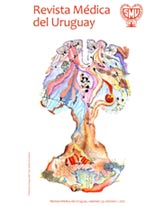Cervical cancer in Uruguay. Controversies in prevention
Keywords:
UTERINE CERVICAL NEOPLASMS, PAPILLOMAVIRUS VACCINES, HEALTH PROMOTION, URUGUAYAbstract
This review provides a critical analysis of the different cervical cancer prevention strategies, with an emphasis on immunization, implementation modalities, health strategies and national regulations.
Rather than favoring or opposing the obligation to observe health policies, the study aims to offer a critical discussion on the strategy.
It is often said that arguments in favor of the obligatory nature of a policy or recommendation are defined by two main axes: the first one refers to defining whether the population is facing a health risk in the population and the second one, whether informed decisions need to be promoted to achieve a larger impact. Thus, defining if addressing HPV infection within a comprehensive prevention strategy, as a sexually transmitted disease, is of paramount importance. To that end, the obligatory nature for all individuals involved in the epidemiological chain should be extensively discussed.
HPV vaccination is recommended in the framework of comprehensive educational programs, as in secondary, tertiary and quaternary prevention. Equality in terms of population protection against cervical cancer needs to be achieved, and in this respect the government needs to take responsibility for these actions and universal access to all strategies. In other words, equal access to vaccination is essential, as well as to other recommended prevention measures.
However, the need to refer to compulsory measures to stop avoidable deaths with measures we already know may be arguable, as this is a way to make up for failure to achieve other preventive measures, which have been demonstrated to reduce cervical cancer incidence and mortality.












